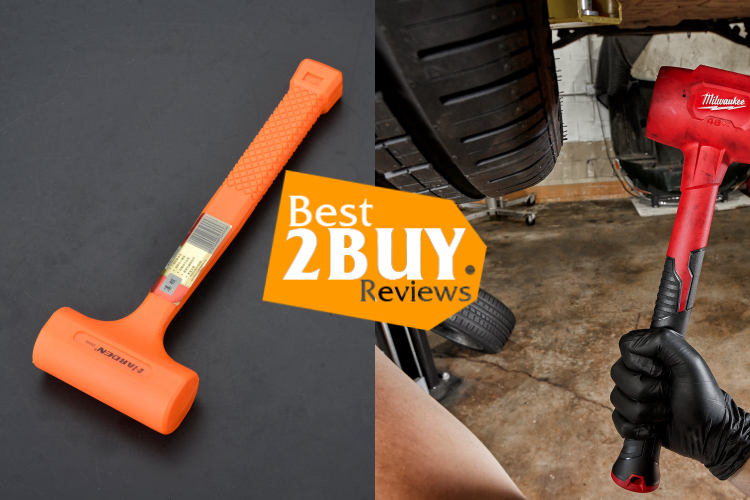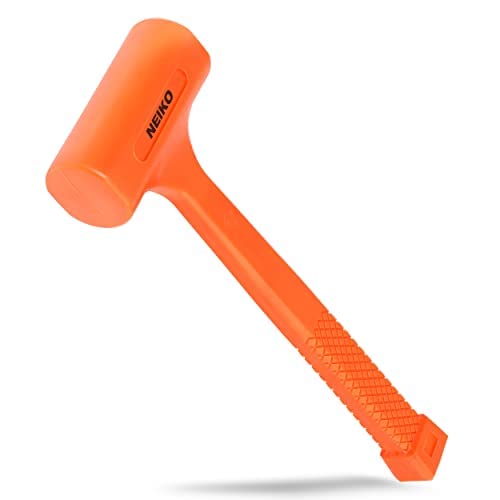Dead-Blow Hammers: A Comprehensive Guide To Choosing The Right One

- 1. Dead-Blow Hammers: A Comprehensive Guide To Choosing The Right One
- 1.1. What is a Dead-Blow Hammer?
- 1.2. Features and Design
- 1.3. Applications and Uses
- 1.4. Advantages of Dead-Blow Hammers
- 1.5. Choosing The Right Dead-Blow Hammer
- 1.5.1. Factors to Consider
- 1.5.2. Application-Specific Considerations
- 1.5.3. Choosing the Right Size
- 1.5.4. Budget Consideration
- 1.6. How To Properly Use A Dead Blow Hammer
- 1.6.1. Prioritize Eye Safety
- 1.6.2. Avoid Excessive Force
- 1.6.3. Use for Small, Brief Tasks
- 1.6.4. Proper Storage
Within the realm of hammers, where power meets accuracy, the dead-blow hammer shines as a remarkably versatile and efficient tool. Differing from conventional models, dead-blow hammers present an innovative design and functionality that transforms our approach to woodworking, metalworking, automotive repair, and general construction tasks. This piece explores the attributes, uses, and advantages of dead-blow hammers, elucidating their importance across diverse industries.
What is a Dead-Blow Hammer?
A dead-blow hammer stands as a specialized hammer variant featuring a hollow head that's filled with loose shot, sand, or similar materials. Typically composed of steel and enclosed in a polymer or rubber head, this filling generates a distinct "dead-blow" impact. Unlike traditional hammers that depend solely on the user's swinging force to deliver impact, dead-blow hammers integrate an internal mechanism that absorbs and redirects energy upon striking.
Features and Design
A dead-blow hammer is characterized by its capacity to reduce rebound and recoil upon impact, primarily due to an internal weight mechanism that absorbs energy, preventing it from transferring back to the user. The intention behind this design is to minimize surface damage and mitigate the potential for user fatigue or injury resulting from repetitive striking.
Typically, the head of a dead-blow hammer is crafted from soft, non-marring materials such as rubber, polyurethane, or various polymers. This construction ensures effective striking force while safeguarding surfaces against damage. As for the handle, it's often made from materials like fiberglass, offering durability without sacrificing shock absorption.
Available in diverse sizes, weights, and shapes, dead-blow hammers cater to different applications. Some models boast multiple striking surfaces—flat, rounded, or even serrated—providing versatility for tasks requiring varying levels of force and precision.
Applications and Uses
These hammers are extensively used in various industries:
- Woodworking: Dead-blow hammers are indispensable in intricate woodworking operations where preserving the surface is crucial. They are employed to assemble joints, fine-tune parts, and encourage the fitting together of tight pieces without leaving unsightly marks.
- Metalworking: Whether it involves shaping metal, aligning components, or repairing dents, dead-blow hammers deliver measured force without causing damage to the workpiece or generating excessive rebound.
- Automotive Repair: Mechanics depend on dead-blow hammers to dislodge parts without causing harm, straighten body panels, and remove stubborn components without marking surfaces.
- General Construction: Dead-blow hammers are used for a range of tasks in construction, from driving stakes and pins to adjusting construction materials. They offer precision and control while reducing the risk of damage.
Advantages of Dead-Blow Hammers
- Diminished Bounce-back: By minimizing rebound through internal design, these hammers enhance safety and comfort during use, lessening strain on the user's arm and wrist.
- Surface Safeguard: Utilizing a soft head material, these hammers safeguard delicate or finished surfaces, averting any potential damage or marks.
- Enhanced Accuracy: The regulated striking force enables precise and controlled blows, significantly assisting in tasks that demand finesse.
- Adaptability: Featuring a range of head shapes and sizes, dead-blow hammers accommodate various tasks, providing versatility across different work environments.
Choosing The Right Dead-Blow Hammer
From automotive work to woodworking and general home improvements, selecting the right dead-blow hammer can significantly impact the outcome of your project. Here’s a comprehensive guide to help you choose the perfect dead-blow hammer for your needs:
Factors to Consider
Material:
- Polyurethane: This material is common for dead-blow hammers. It provides a good balance between durability and non-marring properties.
- Rubber: Offers a softer blow and is suitable for more delicate work, but might lack the durability of polyurethane.
- Steel Shot or Sand Fill: Some hammers contain steel shot or sand to dampen the blow. While effective, these might be noisier compared to other options.
Weight: Dead-blow hammers come in various weights, usually ranging from a few ounces to several pounds. Consider the type of work you’ll be doing and choose a weight that allows for control and adequate force without causing fatigue.
Handle: A comfortable grip is essential, especially for extended use. Look for ergonomic handles that reduce strain on your hand and wrist.
Some hammers have handles with anti-vibration properties, which can be beneficial during prolonged use.
Head Design: Flat, mushroom-shaped, or even cylindrical heads are available. The shape can affect the distribution of force and the precision of the strike. Select a design that aligns with your specific tasks.
Durability: Consider the hammer's construction quality. Hammers made of high-quality materials might be pricier but are likely to last longer and provide consistent performance.
Application-Specific Considerations
- Woodworking: For delicate woodworking tasks, a lighter dead-blow hammer with a softer striking surface is recommended to prevent damage to wood surfaces.
- Metalworking: Heavier hammers with a more durable striking surface are suitable for shaping and manipulating metal without leaving marks.
- Automotive Work: A medium-weight hammer with a durable but non-marring surface is ideal for tasks like removing dents without damaging the vehicle's finish.
Choosing the Right Size
Selecting the appropriate size depends on the type of work you intend to perform. For intricate tasks that require more precision, a smaller-sized hammer might be more suitable. Larger hammers, on the other hand, provide more force and are preferable for heavier-duty tasks.
Budget Consideration
While quality often aligns with price, there are cost-effective options that provide decent performance. Assess your needs and consider the frequency and intensity of use before investing in a dead-blow hammer.
How To Properly Use A Dead Blow Hammer
Here are a few recommendations for ensuring the safe and effective use of this tool:
Prioritize Eye Safety
When using a dead blow hammer, prioritize eye safety by wearing safety goggles. These hammers contain loose particles that help absorb vibrations upon impact. As the surfaces being struck can potentially shatter and scatter debris, it's crucial to protect your eyes. Avoid using the hammer to strike nails, chisels, or other sharp objects to prevent potential eye injuries.
Avoid Excessive Force
Dead blow hammers are constructed from materials like polyurethane and aluminum, which can break if subjected to excessive force against a solid surface. Even if the hammer doesn't break, repeatedly using excessive force will shorten its lifespan.
Use for Small, Brief Tasks
To ensure proper usage, limit the use of dead blow hammers to small, short tasks. They are not designed for high-force jobs, such as demolishing walls. If you must use the hammer for more demanding tasks, ensure it has a secondary coating to protect it from damage.
Proper Storage
Safely store the hammer in a secure space to prevent damage from accidental drops or being stacked under other tools.
Due to their distinctive design and multitude of advantages, dead-blow hammers have entrenched themselves as a fundamental tool across diverse industries. Setting them apart from traditional hammers is their remarkable capacity to administer forceful yet controlled strikes without causing damage or rebound. Their indispensability spans from woodworking to automotive repair, catering to the needs of professionals and DIY enthusiasts alike, prioritizing precision, control, and safety across a range of applications. With the continuous progress in technology and materials, the evolution of these hammers is anticipated to persist, amplifying their usefulness and cementing their status as a perennial favorite in any toolbox.











